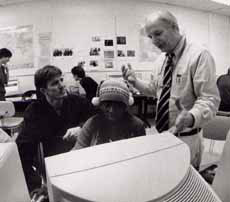ILT Introduces 3-D Models of WTC Site For High School Students
In January of 2002, TC's Institute for Learning Technologies (ILT) launched a school-based initiative that introduces three-dimensional animation tools to New York City public high school students in the context of designing new uses of the two-block area called "Ground-Zero," the site of the destroyed World Trade Center.
Professor Robert McClintock, the Director of ILT, said, "Students at the Beacon School and Bread and Roses Academy will use Active-Worlds technology to create designs for the World Trade Center site." According to McClintock, the project entails a virtual reality construction site where students will have the opportunity to build memorials, buildings and other structures they design to virtually occupy the World Trade Center property.
ActiveWorlds Corporation is a leading provider of three-dimensional modeling technology on the Internet.
"Through the project, students will follow a curriculum component eliciting their personal reflections on the disaster. They will engage in moderated discussions about re-building in order to agree upon a plan for implementation. Technically, the project will lead to their mastery of 3-D building tools. ActiveWorlds has developed a special site for this project that provides a 3-D model of World Trade Center area cleared of the debris of the 9/11 terror strikes," said McClintock.
This project is part of ILT's efforts to develop online mapping and modeling resources that encourage students to draw connections between what they learn in cyberspace and what they learn about the world of palpable experience.
McClintock said, "We think that a stronger connection between the representation of the world online with that of everyday experience will lead to increased transference between knowledge acquired about the real world and computer-based information and inquiry. In the long-range, we aim to design user-interfaces, and information resources activated through them, that people will experience as natural extensions of their embodied self."
ILT expects to continue working with ActiveWorlds as a technical partner in exploring the educational potentials of 3-D user-interfaces and information management.
Published Sunday, May. 19, 2002
